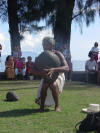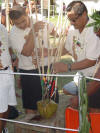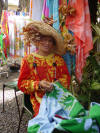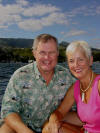|
Tahiti and Moorea
July 2002
When last heard from,
Raven was leaving the Tuamotus headed for the southern coast of Tahiti. We
made another overnight passage to get there and had good winds, but probably
the biggest seas of the trip so far. Jan thinks the swells were about 8 feet
high, and I say they were at least 10 feet. When the boat went down into a
swell, I couldn’t see out, so you can visualize that for yourselves. They
were also coming from abeam (the side) so it was kind of rolly and
uncomfortable. Luckily it was only one night.
Tahiti Iti
 At
our first sight of Tahiti Iti, which is the smaller, southeast lobe of the
island, all we could see was mist covered mountains and big surf crashing on
the shore. Later we found out that this is a surfing area where people fly
in from all over the world to try for the perfect wave. For all you surfers,
or wannabes, it’s called Teahupu. At
our first sight of Tahiti Iti, which is the smaller, southeast lobe of the
island, all we could see was mist covered mountains and big surf crashing on
the shore. Later we found out that this is a surfing area where people fly
in from all over the world to try for the perfect wave. For all you surfers,
or wannabes, it’s called Teahupu.
There were several possible passes into the lagoon behind
the reef,
but with the big swells running, they were very
difficult to spot. In our Charlie’s Charts of Polynesia (one of the
huge shelf of reference books we have for anchorages and navigating) there
was one pass that was so wide that a French aircraft carrier had used it. We
decided that was just our speed. Even then, we couldn’t see the calm water
until we were right in the pass, with huge rollers and surfers on either
side of us. Mercifully, the French have put very good navigation markers in
all the passes and channels, so once we found the right series of markers
and a range to follow, we knew we would be OK.
 We
went from misty rain and rollers to total calm in the lagoon behind the
reef, with no other cruising boats in sight, just a couple local fishing
boats. It is quite incredible how much the land is protected from the
violence of the sea by the coral reef. The down side is that there are few
natural beaches on Tahiti, but we didn’t really come for the beach life
anyway. We
went from misty rain and rollers to total calm in the lagoon behind the
reef, with no other cruising boats in sight, just a couple local fishing
boats. It is quite incredible how much the land is protected from the
violence of the sea by the coral reef. The down side is that there are few
natural beaches on Tahiti, but we didn’t really come for the beach life
anyway.
We stayed anchored there in Vairao for two nights and made
some very brief excursions ashore since it was still raining. There was a
small market where we could get the first tomatoes we’d had in a month, some
baguettes and ice cream bars! Life was good!
We stayed in the lagoon and followed the navigational
markers through a tortuous channel marking the coral reefs (to be avoided at
all costs!) to the hurricane hole called Port Phaeton. It was a beautiful
calm anchorage with restaurants and even supermarkets in the town of Taravao,
about half a mile away. You may find this hard to believe, but after
shopping in the poorly stocked stores of the Marquesas and Tuamotus, we
spent hours just admiring all the stuff in the supermarkets. There
were also street stalls selling vegetables, fruit, and roasted chickens.
Never did we think that fresh lettuce, tomatoes, and even pineapples would
seem such a luxury. And what a treat it was to have lunch in restaurants
several days in a row.
Gauguin was here
We slowly moved along the southern coast enjoying the
peacefulness and access to stores. It usually meant going out into the ocean
via one pass and into the next, since there are many coral reefs along the
way. It was all so well marked that our patented
Signe-as-bow-lookout/buoy-spotter-and-Jan-as-helmsman system worked very
well.
Our next anchorage was next to Tahiti’s Botanical Gardens
and the Gauguin Museum. It had been a long time since we had had access to a
museum of any kind, so we were really looking forward to it. Unfortunately,
there is very little of substance, only leftover displays from Gauguin
exhibits in other parts of the world. The gift shop had more of interest
than the museum itself. It was all a bit sad, especially in such a beautiful
location. We were happily anchored off of lovely gardens with Tahitian
families picnicking and swimming for Father’s Day. Children were jumping off
of a curvy palm tree temptingly hanging over the water. The restaurant next
to the Museum was doing a huge business and didn’t have room for us, but we
enjoyed the Polynesian music all afternoon from our own cockpit. It was
quite a sublime experience thinking about Gauguin and his lovely paintings,
which still portray the colors, people and flowers of Polynesia without too
much difference between the 1800’s and today. Well, maybe there is a little
less topless exposure, but the women are still beautiful, they still wear
pareos and flowers in their long black hair, and it is all set against a
lush green background.
This is a very rural part of Tahiti where very few cruising
boats ever explore, so we felt like we were breaking new ground. In a week
spent on the southern coast, we met one other cruising boat, a German couple
who had sailed northeast from New Zealand to spend another season in
paradise.
Moorea
 It
was so idyllic that we would still be anchored there except for the
approaching Puddle Jump Reunion on Moorea. About 25 of the boats that left
Mexico with us were anchored in Cook’s Bay - every cruiser's dream
destination - so we just had to be there to see old friends, and new ones
too, since everyone in an anchorage is invited to any parties. It
was so idyllic that we would still be anchored there except for the
approaching Puddle Jump Reunion on Moorea. About 25 of the boats that left
Mexico with us were anchored in Cook’s Bay - every cruiser's dream
destination - so we just had to be there to see old friends, and new ones
too, since everyone in an anchorage is invited to any parties.
  We
had three days of comparing passages, anchorages, and adventures. Then we
had three more days of talking about what broke, what was scary, and what we
would do differently the next time. Interspersed with all of this was a
fabulous dinner with music and singing. One night we had a dinghy raft up
cocktail party a la Mexicana when we saw the most magnificent, vivid
green flash at sunset. That one convinced the many skeptics in the fleet who
thought this green flash stuff was just a big myth. (What’s a green flash?
Click here. ) We
had three days of comparing passages, anchorages, and adventures. Then we
had three more days of talking about what broke, what was scary, and what we
would do differently the next time. Interspersed with all of this was a
fabulous dinner with music and singing. One night we had a dinghy raft up
cocktail party a la Mexicana when we saw the most magnificent, vivid
green flash at sunset. That one convinced the many skeptics in the fleet who
thought this green flash stuff was just a big myth. (What’s a green flash?
Click here. )
  The
Official Puddle Jump Reunion Party was held on June 26th at a
restaurant over the water. We all dressed in pareos (men too!), and
the women had flower crowns, worn here for festive occasions. After a great
buffet dinner we were entertained by more of our cruiser musicians and a
hula dance demonstration. Mary of Avventura grew up in Hawaii and
learned to dance the hula there. She also taught a very comely foursome of
men to hula to “Ukelele Lady.” Picture Jan and three bare-chested cohorts in
pareos and flower crowns. Only the videos can do it all justice. For
a small fee to the Admiral of Raven, you too can have blackmail
material. The
Official Puddle Jump Reunion Party was held on June 26th at a
restaurant over the water. We all dressed in pareos (men too!), and
the women had flower crowns, worn here for festive occasions. After a great
buffet dinner we were entertained by more of our cruiser musicians and a
hula dance demonstration. Mary of Avventura grew up in Hawaii and
learned to dance the hula there. She also taught a very comely foursome of
men to hula to “Ukelele Lady.” Picture Jan and three bare-chested cohorts in
pareos and flower crowns. Only the videos can do it all justice. For
a small fee to the Admiral of Raven, you too can have blackmail
material.
One day we rented a car and circumnavigated Moorea. It is a
magnificent island with steep green mountains and turquoise water below.
There are lush, jungly gardens along the way with only occasional groups of
shops to mar the beauty. We visited Moorea sixteen years ago (on a business
trip, believe it or not!) and expected huge developments of tourist hotels
and shops, but happily the island has kept its Polynesian flavor. The hotels
have adopted the format of thatched roof cottages over the lagoon, rather
than high-rise hotel buildings. They have definitely done it right.
Papeete
Finally it was time to head for Papeete, the Big City with
a population of 125,000, fully half the people in all of French Polynesia.
We had heard some pretty sad tales of the noise, the dirt, the crime, etc.
We will admit that it was quite a shock to get back into the middle of it
all, but didn’t find it too horrible. We decided not to do the classic thing
and anchor in the middle of town, stern to the quay. It was noisy and dirty
sixteen years ago and hasn’t improved with age.
  We
are anchored in the lagoon about five miles from the center of town, off of
the Maeva Beach hotel, just inside the barrier reef. We can swim and snorkel
right off the boat and have a fantastic view of Moorea across the channel.
The sun sets gorgeously between two of Moorea’s peaks. We take a bus called
le truck into town if we want to shop at the open-air market, have
dinner on the waterfront, or visit the innumerable pearl shops. The best
supermarket on the island is within walking distance of our anchorage with
an incredible selection of French cheeses, wines, vegetables and fruits and
almost anything we could ever want – at breathtaking prices, of course. My
first cart (that’s one, singular) of groceries cost $557 (not a misprint),
and I bought just the basics. But I’m thrilled just to have access to it
all! We
are anchored in the lagoon about five miles from the center of town, off of
the Maeva Beach hotel, just inside the barrier reef. We can swim and snorkel
right off the boat and have a fantastic view of Moorea across the channel.
The sun sets gorgeously between two of Moorea’s peaks. We take a bus called
le truck into town if we want to shop at the open-air market, have
dinner on the waterfront, or visit the innumerable pearl shops. The best
supermarket on the island is within walking distance of our anchorage with
an incredible selection of French cheeses, wines, vegetables and fruits and
almost anything we could ever want – at breathtaking prices, of course. My
first cart (that’s one, singular) of groceries cost $557 (not a misprint),
and I bought just the basics. But I’m thrilled just to have access to it
all!
Heiva
  The
main reason for being in Papeete in July is to attend the events of Heiva,
which is a month-long celebration of the arts and culture of Polynesia. Most
of the islands have their own Heiva competitions, but Papeete’s is
the biggest. We saw two of the six evenings of magnificent Polynesian song
and dance performances. Each night there was one group of amateur dancers,
one group of singers, and one professional group of dancers. The
main reason for being in Papeete in July is to attend the events of Heiva,
which is a month-long celebration of the arts and culture of Polynesia. Most
of the islands have their own Heiva competitions, but Papeete’s is
the biggest. We saw two of the six evenings of magnificent Polynesian song
and dance performances. Each night there was one group of amateur dancers,
one group of singers, and one professional group of dancers.
 Each
singing or dancing group has well over a hundred members, coached by
professionals, with major investments of time and money in costuming, music,
choreography, etc. The amateur dance groups were “amateur” in a very
different sense from our word. There are certain traditional elements and
rules that are part of each dance, a bit like the compulsory figures in
ice-skating. As we watched more performances, we became aware of these
subtleties and could begin to compare. The dancers were mostly in their
teens and were full of energy and enthusiasm. They were obviously having a
great time with their friends and were thrilled at the honor of performing
on the big outdoor stage. Each
singing or dancing group has well over a hundred members, coached by
professionals, with major investments of time and money in costuming, music,
choreography, etc. The amateur dance groups were “amateur” in a very
different sense from our word. There are certain traditional elements and
rules that are part of each dance, a bit like the compulsory figures in
ice-skating. As we watched more performances, we became aware of these
subtleties and could begin to compare. The dancers were mostly in their
teens and were full of energy and enthusiasm. They were obviously having a
great time with their friends and were thrilled at the honor of performing
on the big outdoor stage.
We were not sure what to expect of the singing groups, but
were very pleasantly surprised. Again, the songs have traditional forms and
elements. Most songs are newly composed but have the rhythms of various
kinds of work: hauling nets, pounding taro, or making copra. The harmonies
are quite different from our music, but fascinating combinations of male
bass rhythms and female verse, almost like a round. Each group had about a
hundred singers, all dressed in the same Polynesian fabric, vibrantly
colorful and in an infinite variety of floral patterns. Plain colors are
never going to cut it in these islands!
  The
professional dance groups were incredible. We’ve seen two now, and I can’t
wait to hear whether my favorite has won the Grand Prize. The groups have
three changes of costume: pareos or fabric costumes, vegetal or
natural costumes (flowers, ferns, leaves, etc.), and The Grand Costume,
which evokes traditional Polynesian garb. The creativity of my favorite
group was quite breathtaking. For example, the traditional male costume of
green leaves was augmented by leis and headdresses made of real fruit and
vegetables – pineapples, oranges, bananas, etc. Their music was also beyond
any of the other groups. The
professional dance groups were incredible. We’ve seen two now, and I can’t
wait to hear whether my favorite has won the Grand Prize. The groups have
three changes of costume: pareos or fabric costumes, vegetal or
natural costumes (flowers, ferns, leaves, etc.), and The Grand Costume,
which evokes traditional Polynesian garb. The creativity of my favorite
group was quite breathtaking. For example, the traditional male costume of
green leaves was augmented by leis and headdresses made of real fruit and
vegetables – pineapples, oranges, bananas, etc. Their music was also beyond
any of the other groups.
Then there is the dance itself. I think genetically the
Polynesians must be built differently from us. There is no way my hips could
ever move like that, or so fast!! The gestures are much like Hawaiian hula,
but livelier with lots of drumming as accompaniment.
More Heiva
 The
Autonomy Day Parade, celebrating the islands’ domestic autonomy from France,
was another Experience. We had prime seats in bleachers along the parade
route and couldn’t figure out why so few locals were there. It turns out
that almost everyone on the island is in the parade! All the dance clubs,
all the soccer teams, all the tennis teams, all the surf clubs, all the body
building clubs, even the hot rod clubs were represented. It was a bit long,
but again showed every variety of Polynesian flowered fabric in the groups’
matching costumes. The
Autonomy Day Parade, celebrating the islands’ domestic autonomy from France,
was another Experience. We had prime seats in bleachers along the parade
route and couldn’t figure out why so few locals were there. It turns out
that almost everyone on the island is in the parade! All the dance clubs,
all the soccer teams, all the tennis teams, all the surf clubs, all the body
building clubs, even the hot rod clubs were represented. It was a bit long,
but again showed every variety of Polynesian flowered fabric in the groups’
matching costumes.
  The
javelin throwing contest, where about fifty competitors in teams of three
throw ten javelins each in seven minutes, is more like an ancient
battlefield than the Olympic javelin. All this happened in fearsome bursts
of flying steel-pointed sticks all aimed at a coconut on a pole ten meters
in the air. Not only did they have to hit the coconut – maybe twenty
javelins in each round did that – but only the javelin stuck in the nut
closest to the top won the single point for that round. Apparently this all
started in the Tuamotus as a spear fishermen’s activity to pass the time
until the fish started biting. There was also a demonstration with a skinny
guy lifting an enormous volcanic beach stone, a traditional athletic event. The
javelin throwing contest, where about fifty competitors in teams of three
throw ten javelins each in seven minutes, is more like an ancient
battlefield than the Olympic javelin. All this happened in fearsome bursts
of flying steel-pointed sticks all aimed at a coconut on a pole ten meters
in the air. Not only did they have to hit the coconut – maybe twenty
javelins in each round did that – but only the javelin stuck in the nut
closest to the top won the single point for that round. Apparently this all
started in the Tuamotus as a spear fishermen’s activity to pass the time
until the fish started biting. There was also a demonstration with a skinny
guy lifting an enormous volcanic beach stone, a traditional athletic event.
Then we went to the fruit carriers’ competition. Each man
carried a bamboo pole hung with coconuts, pineapples, papayas and flowers
adding about 100 pounds. They had to run barefoot (and sometimes bare-bunned;
a few of the guys wore thongs of that ever present Polynesian fabric!)
around a one-mile course. It seemed to be quite strenuous, but fun to watch.
We also saw parts of the fire dancing and Tahitian foxtrot
competitions. These weren’t as interesting as some of the other events, so
we recessed to having dinner at the local food stalls, called roulottes.
These open-sided vans occupy a big area next to the cruise ship docks every
night of the week. They serve everything from chow mein to pizza,
steack-frites (French spelling), and crêpes. They are so
good and so full of outdoor picnic atmosphere that we haven’t even checked
out the other restaurants in town.
  The
other major Heiva draw is the artisans’ fair. I went three times, it
was so wonderful. It is in an out-of-the-way part of town, so not many
tourists see it. Every day there are song and dance performances with
everything in Tahitian – no French, let alone English. All of the islands
send their best crafts people with The
other major Heiva draw is the artisans’ fair. I went three times, it
was so wonderful. It is in an out-of-the-way part of town, so not many
tourists see it. Every day there are song and dance performances with
everything in Tahitian – no French, let alone English. All of the islands
send their best crafts people with
 crates
full of their wares – wood carvings, shell jewelry, tifaifai
(appliquéd quilts), clothing, baskets, hats, even tattoo artists. It was
fabulous!!! Luckily we are flying home soon and I can offload some of my
hidden booty. crates
full of their wares – wood carvings, shell jewelry, tifaifai
(appliquéd quilts), clothing, baskets, hats, even tattoo artists. It was
fabulous!!! Luckily we are flying home soon and I can offload some of my
hidden booty.
As I type this, we are packing for two weeks in the US.
We’ll visit Paul and Michelle in San Francisco for a week, then fly to
Tacoma for a round of visiting Jan’s Mom, annual checkups, shopping for boat
parts, and filing the tax return. Hopefully, we’ll get to see a few friends
too. Mark and his girlfriend Jaye are here to boat-sit Raven in our absence.
 When
we return to Papeete we’ll have one last round of provisioning before
heading north and west to Huahine, Raiatea, and Bora Bora until the middle
of September. When
we return to Papeete we’ll have one last round of provisioning before
heading north and west to Huahine, Raiatea, and Bora Bora until the middle
of September.
We are taking home lots of photos for these pages, so we
hope you will enjoy them.
Previous log
Next log
This page was last
updated on
04/13/04. |